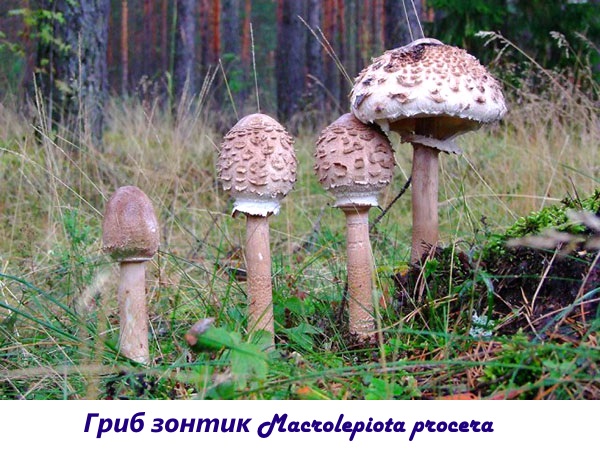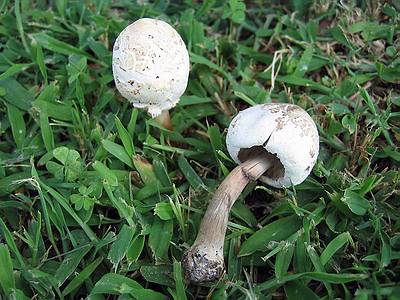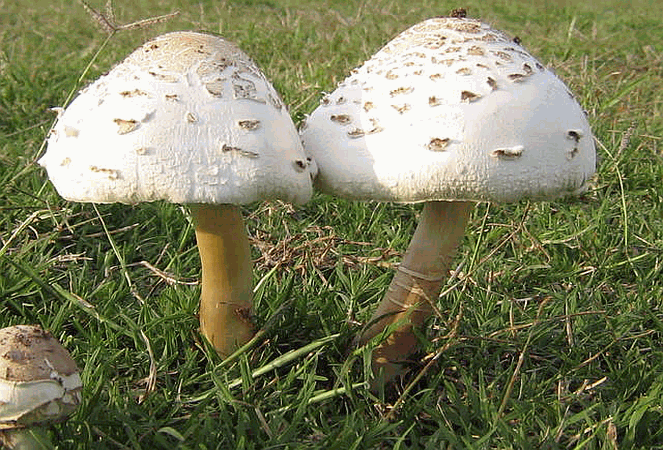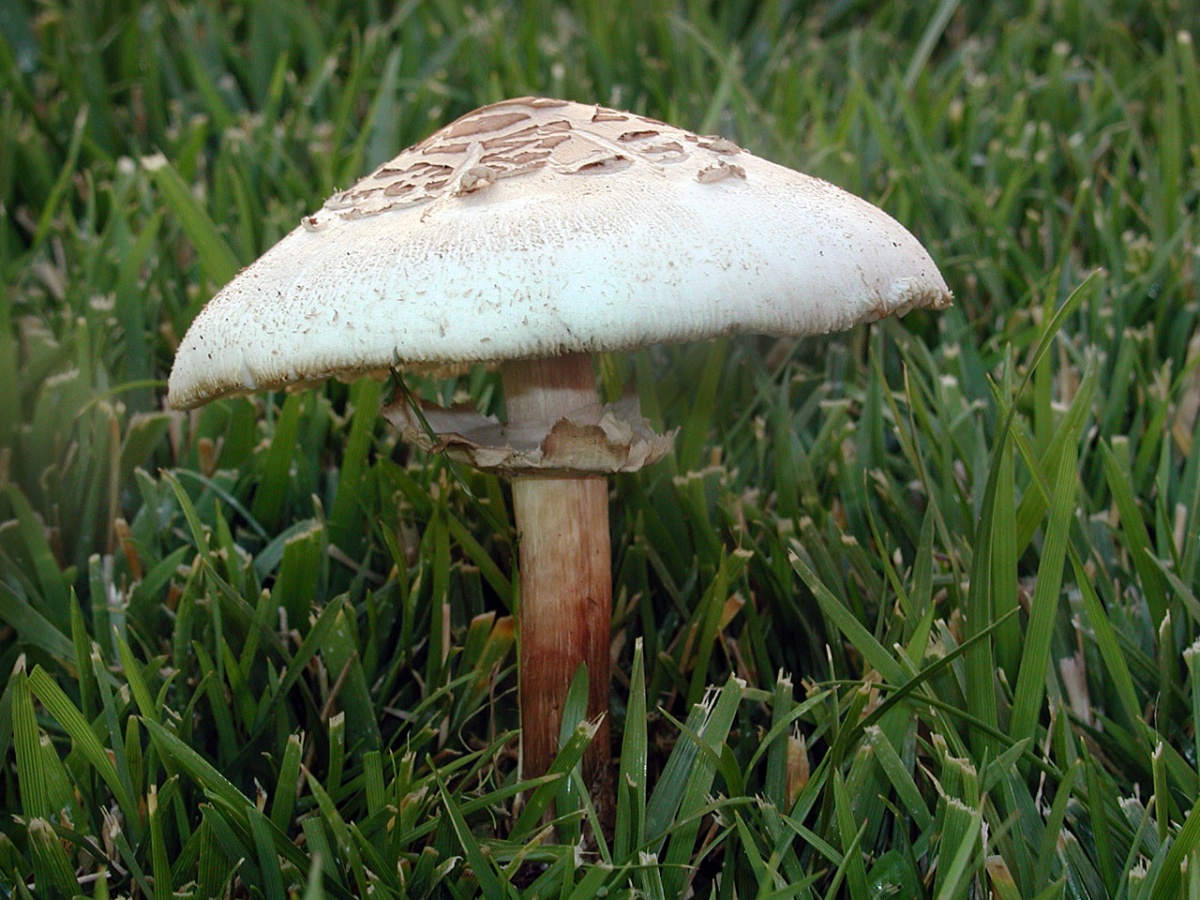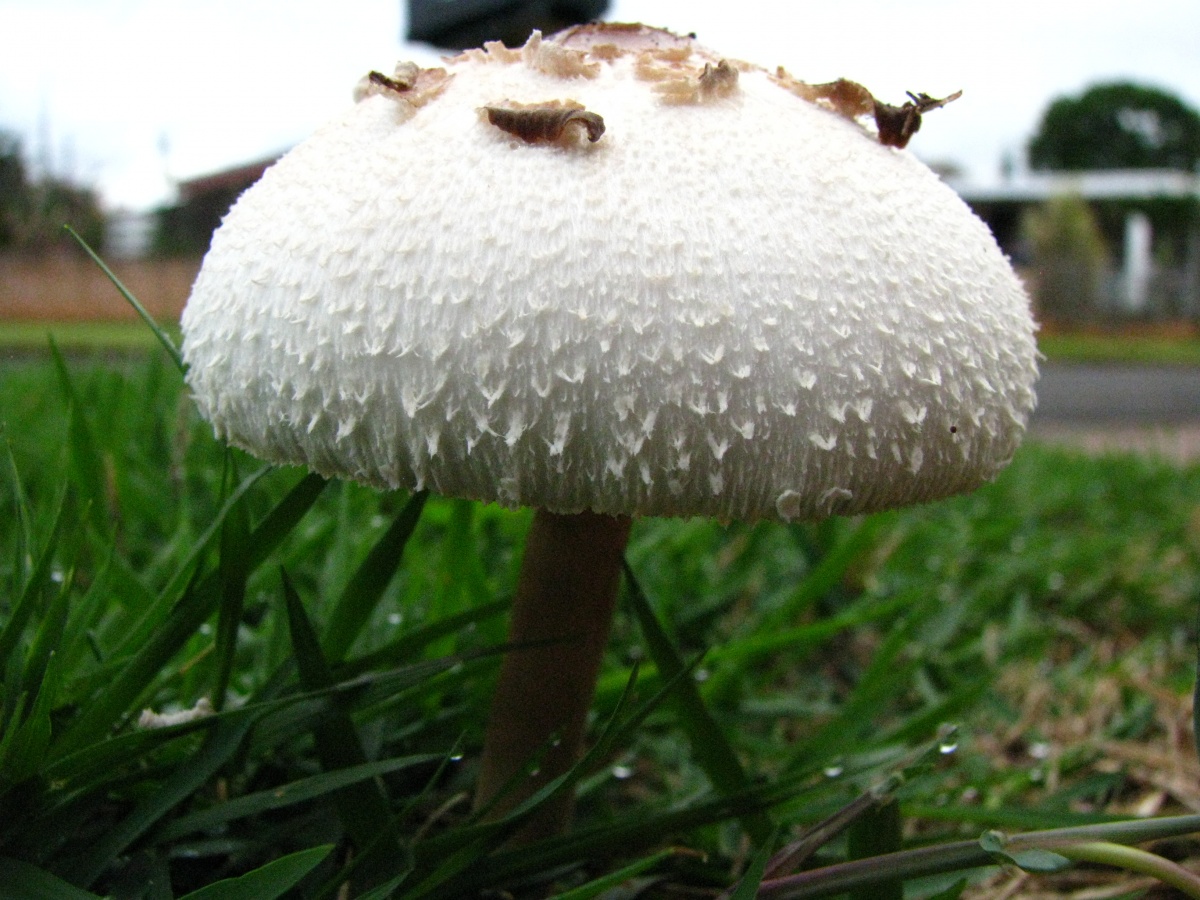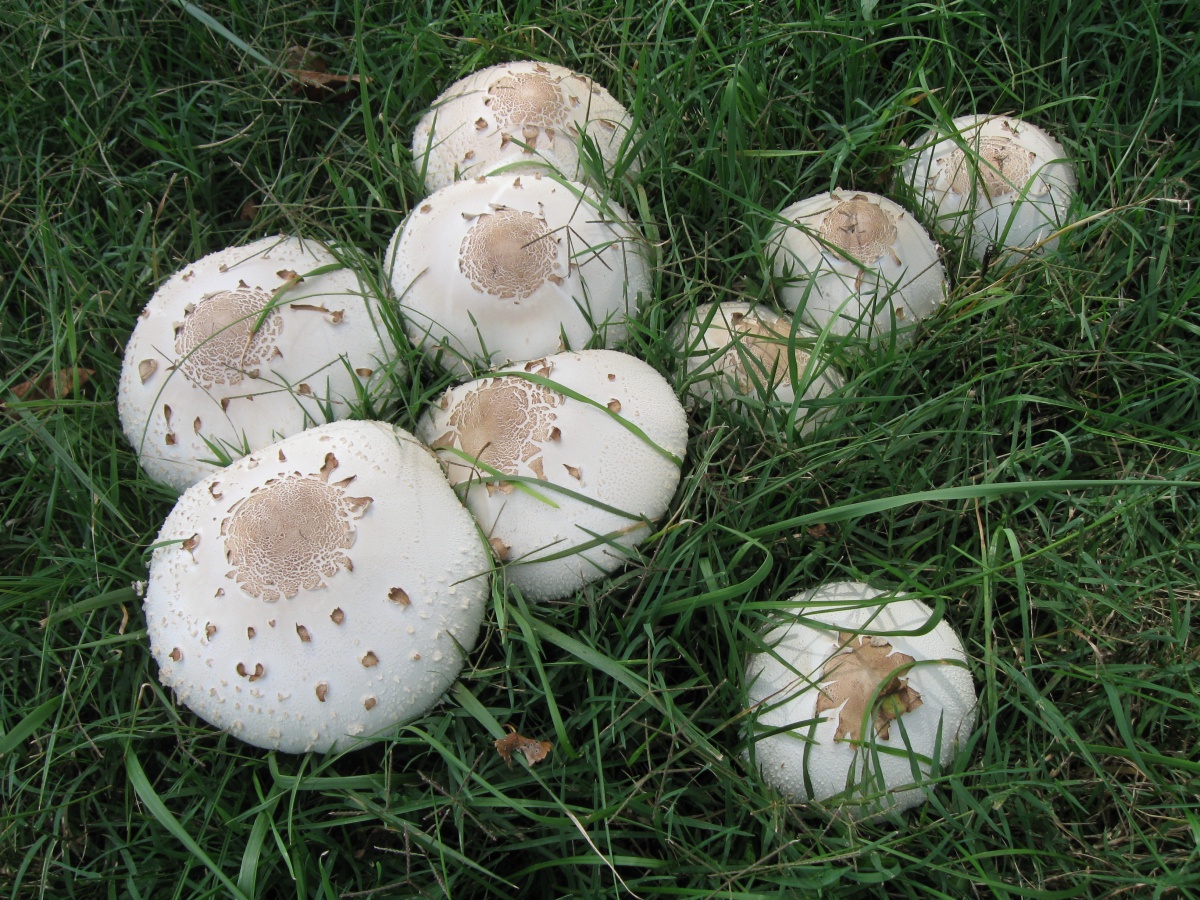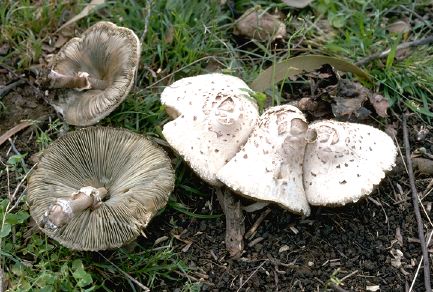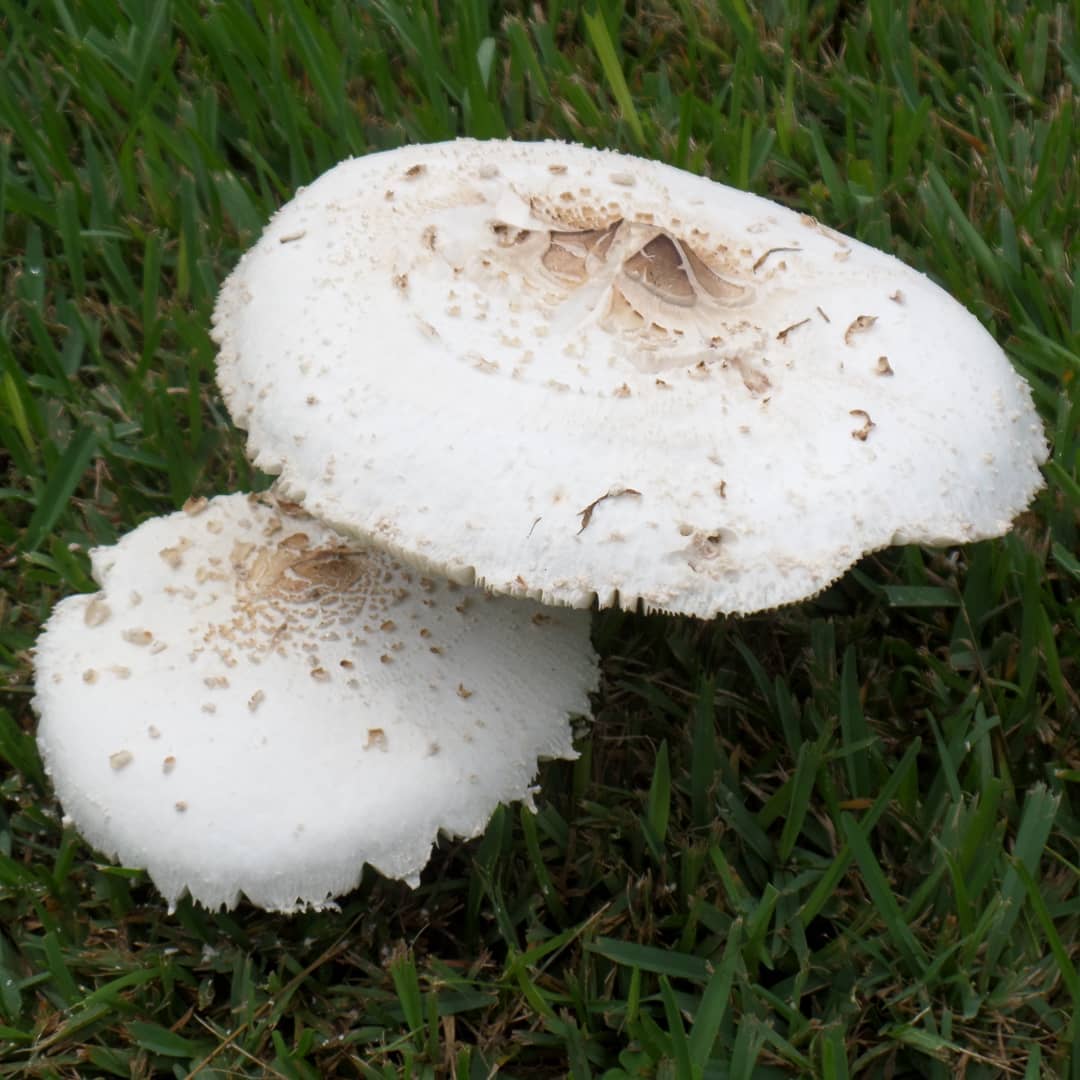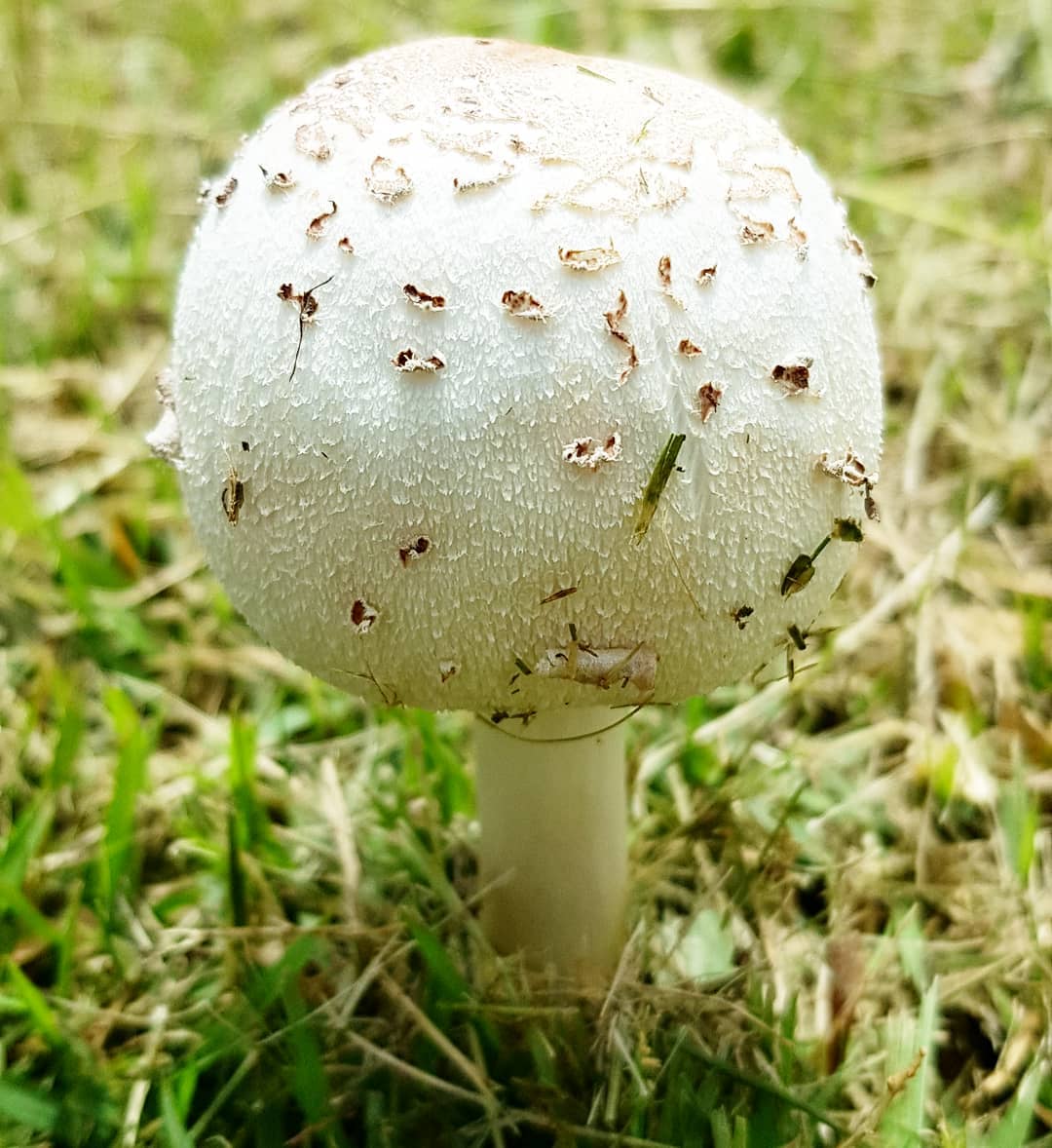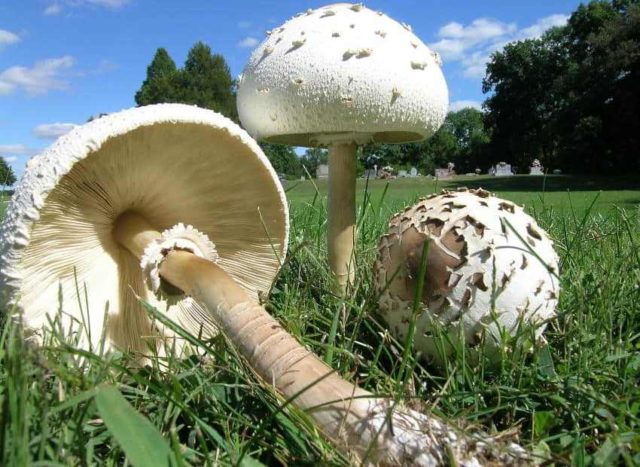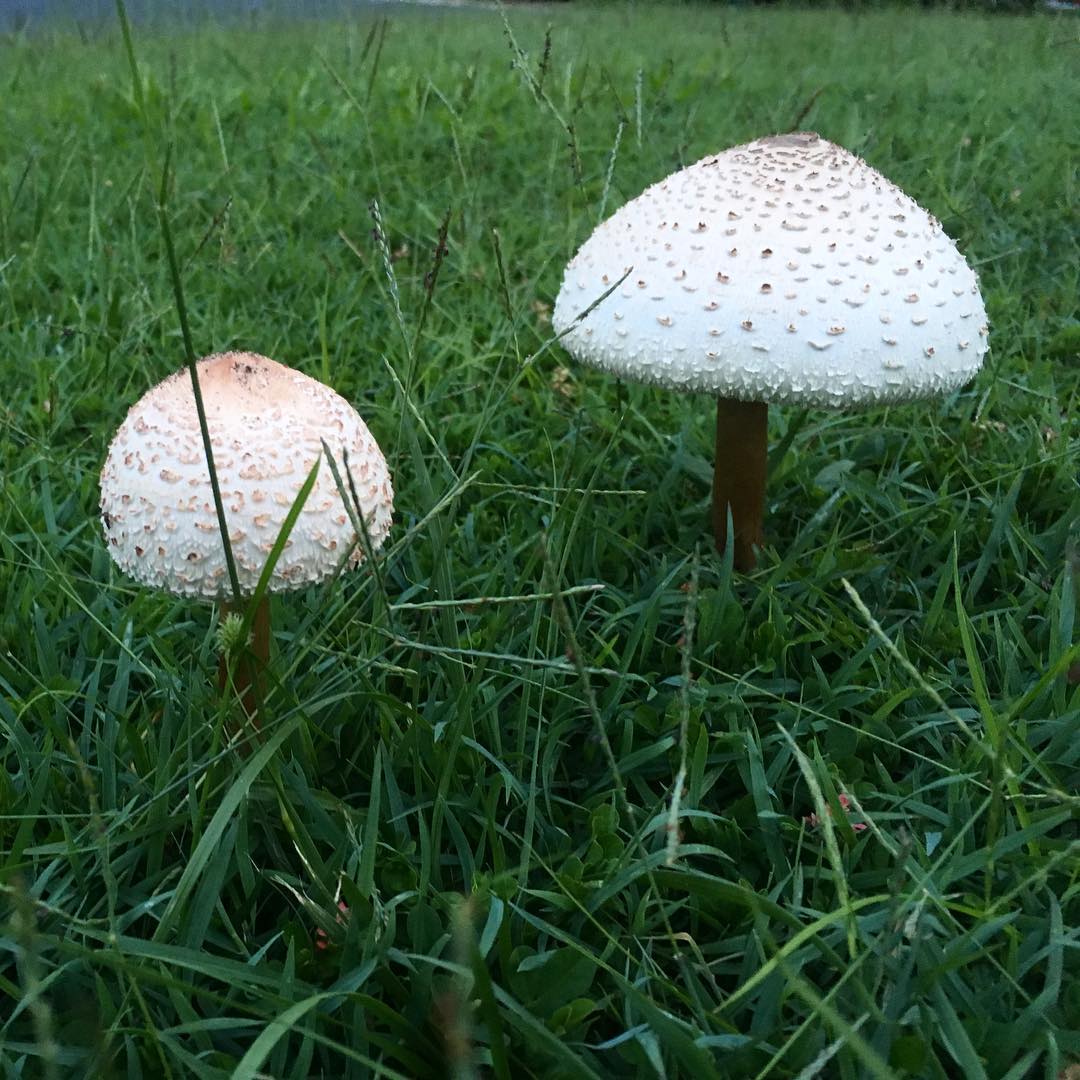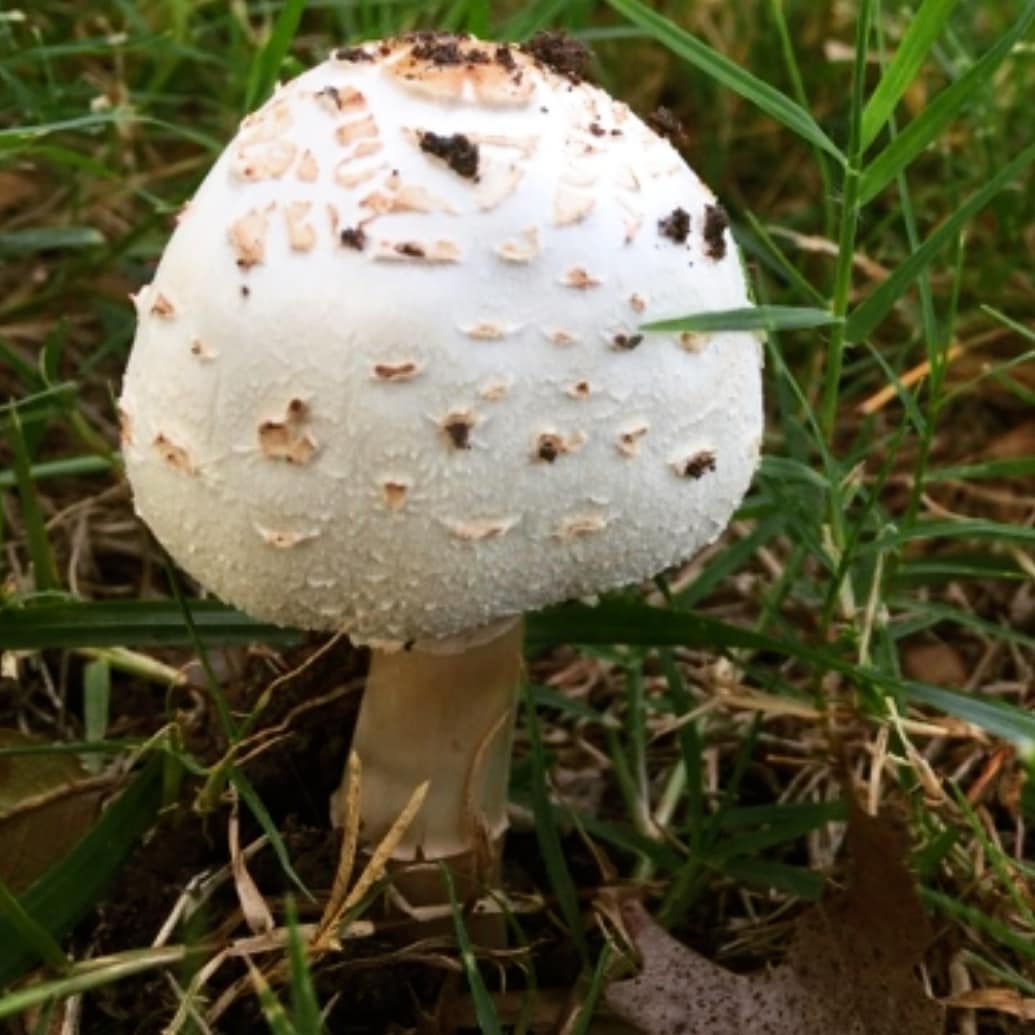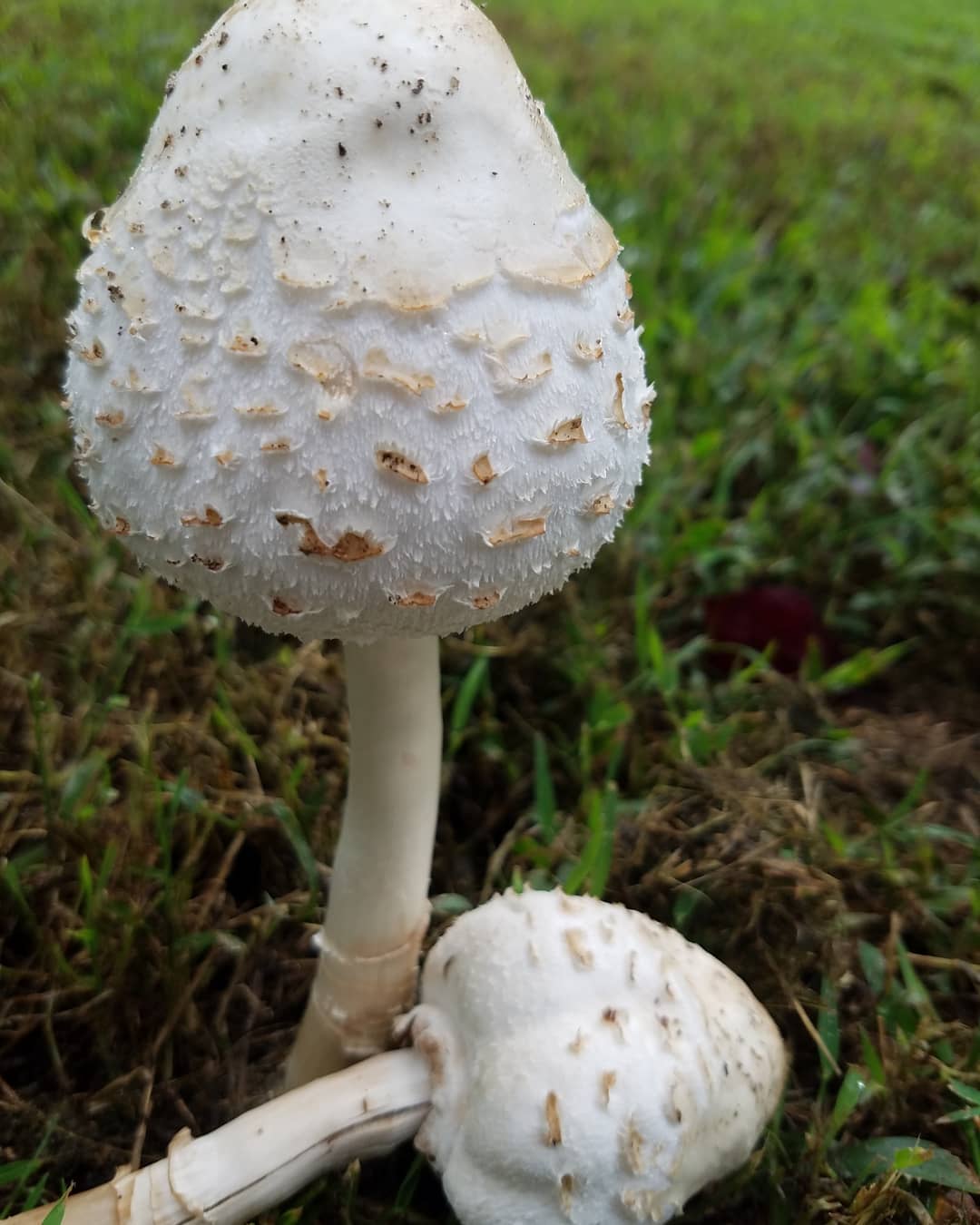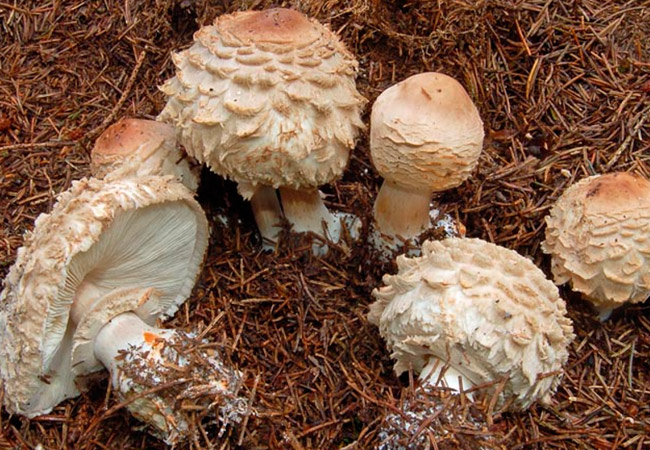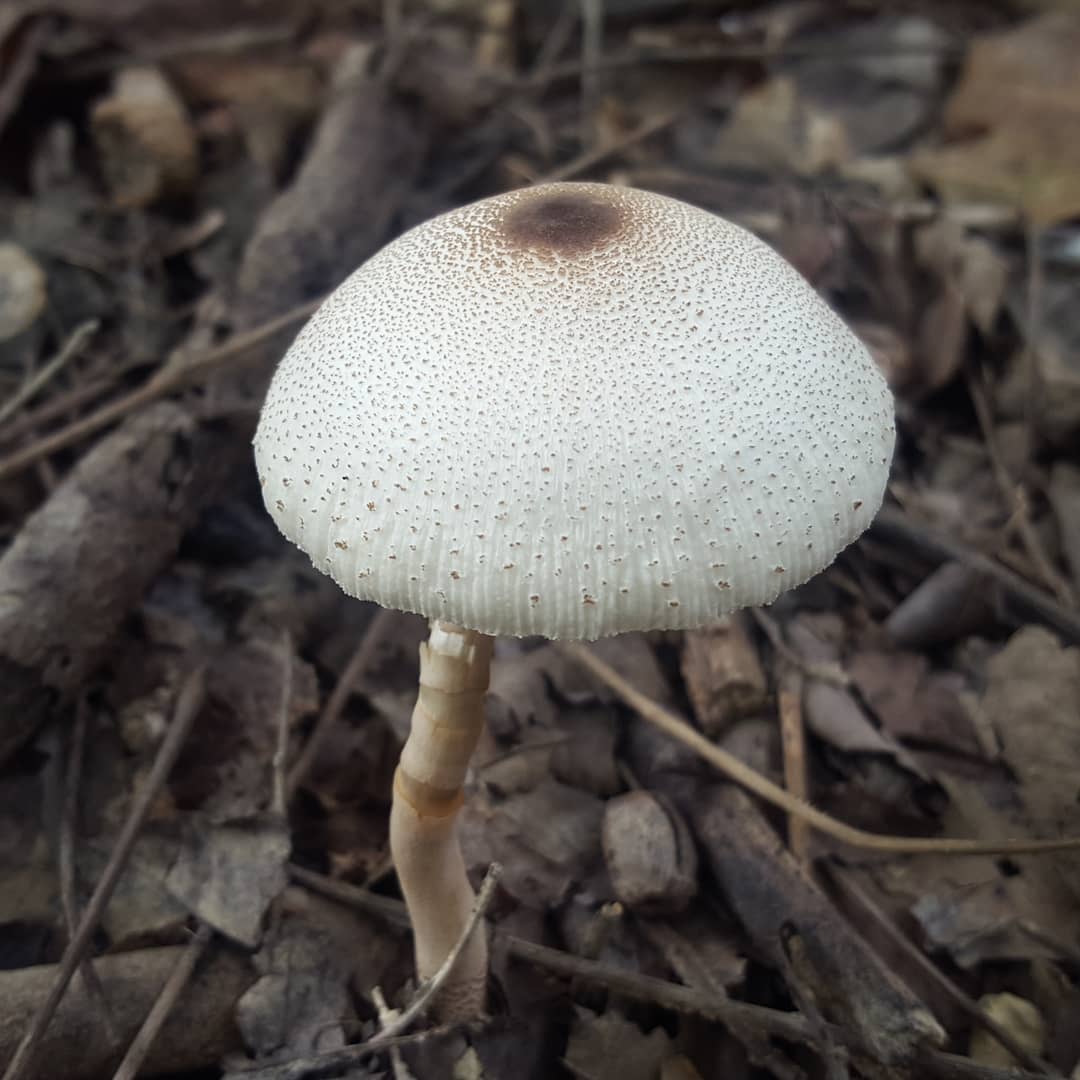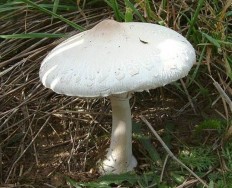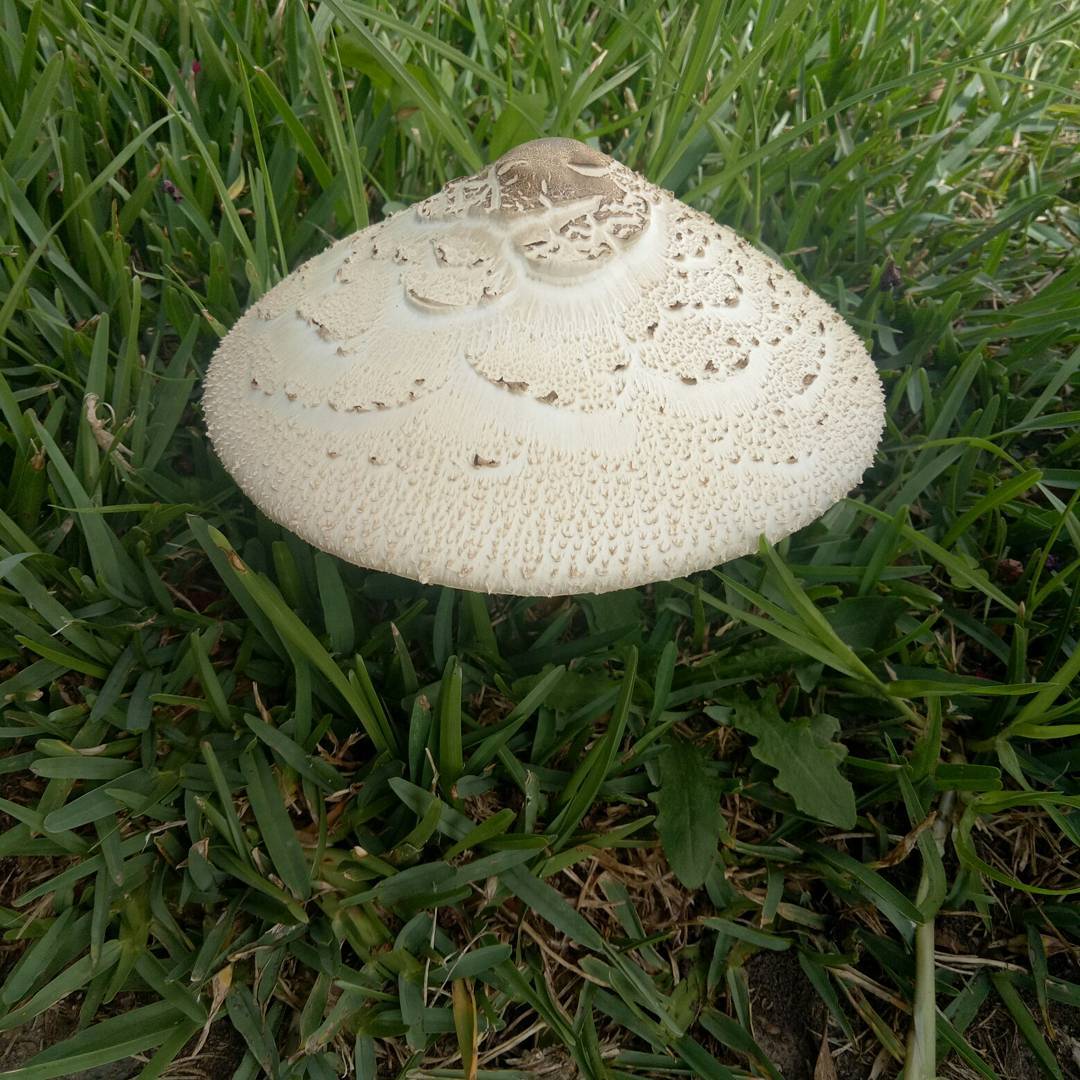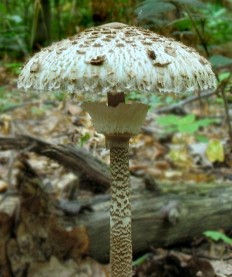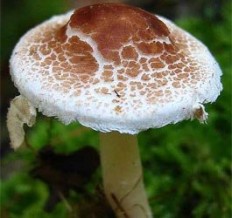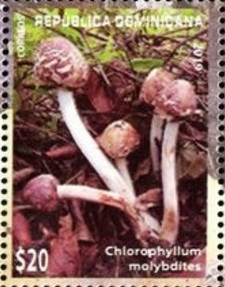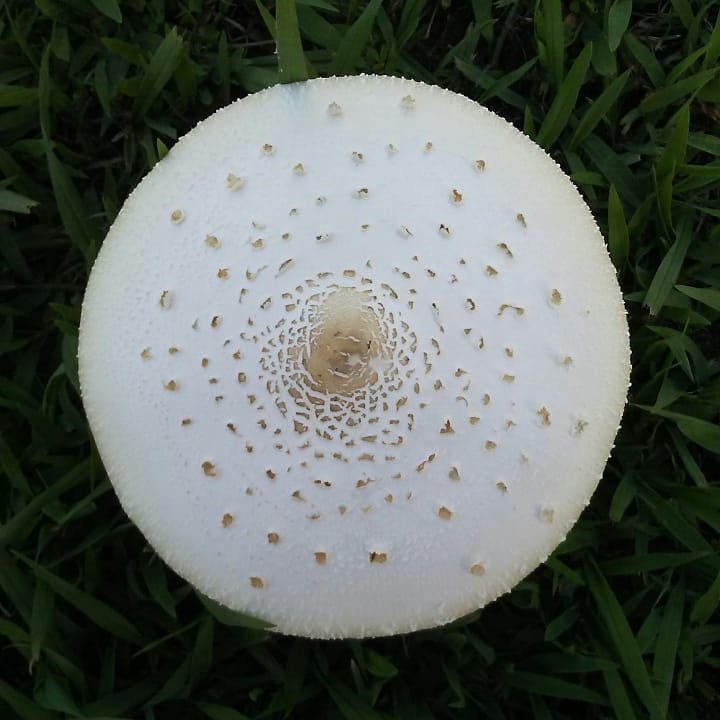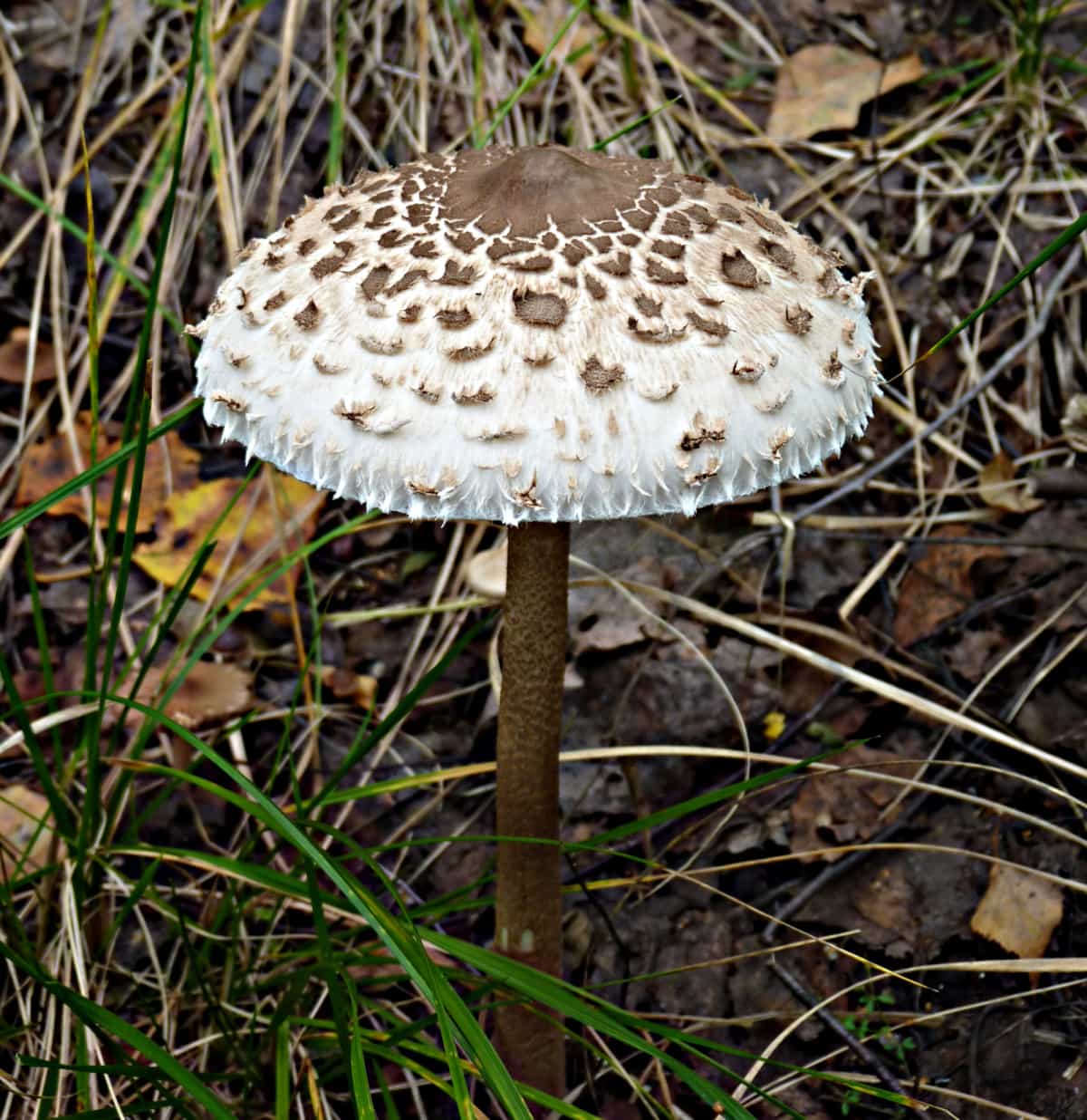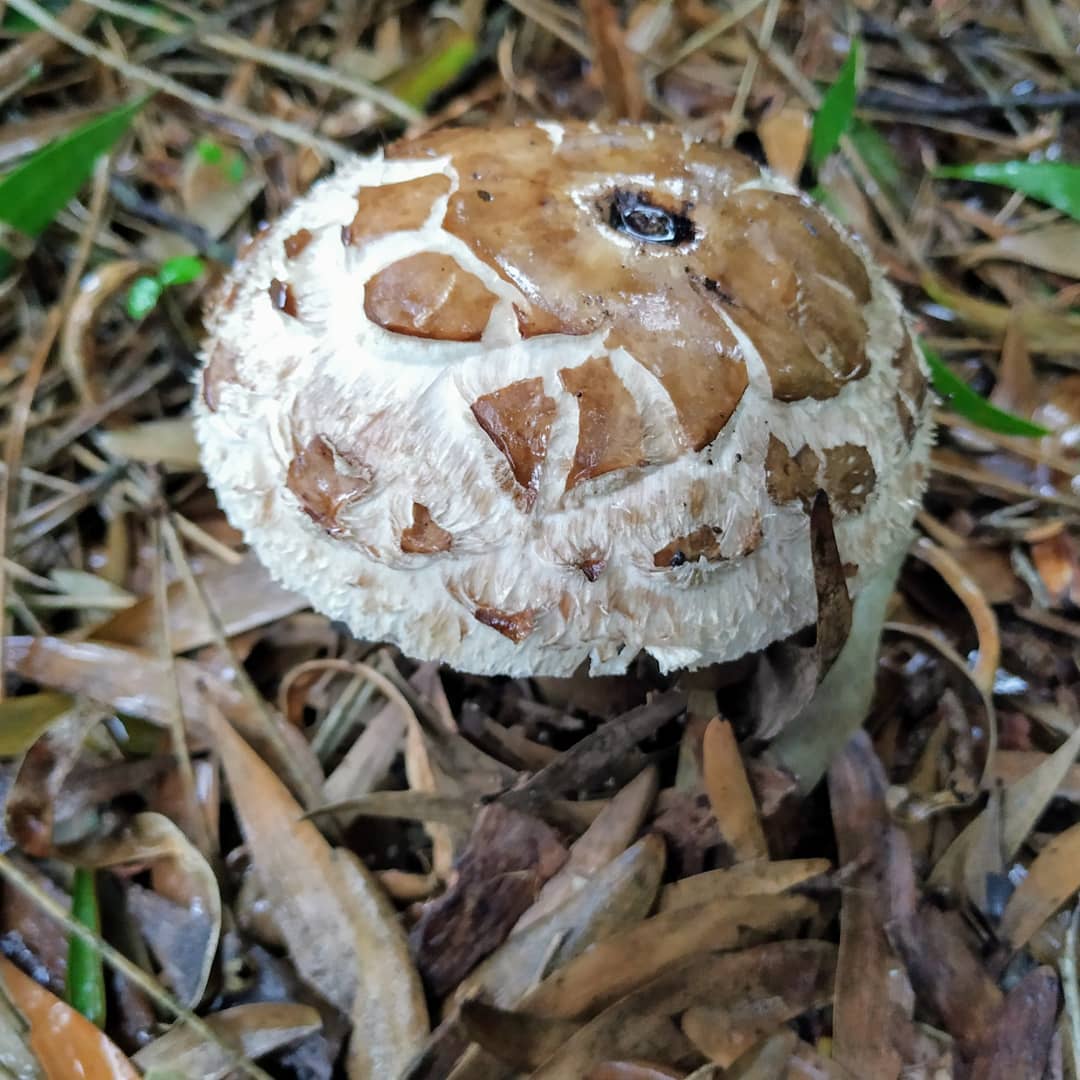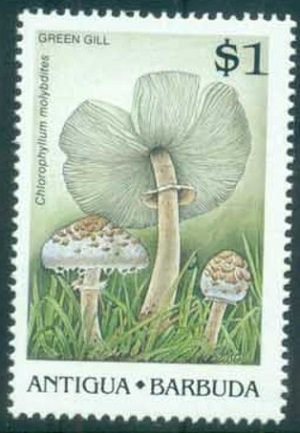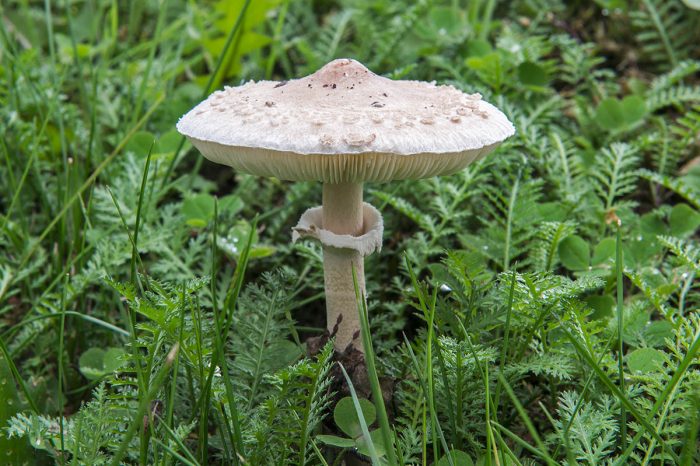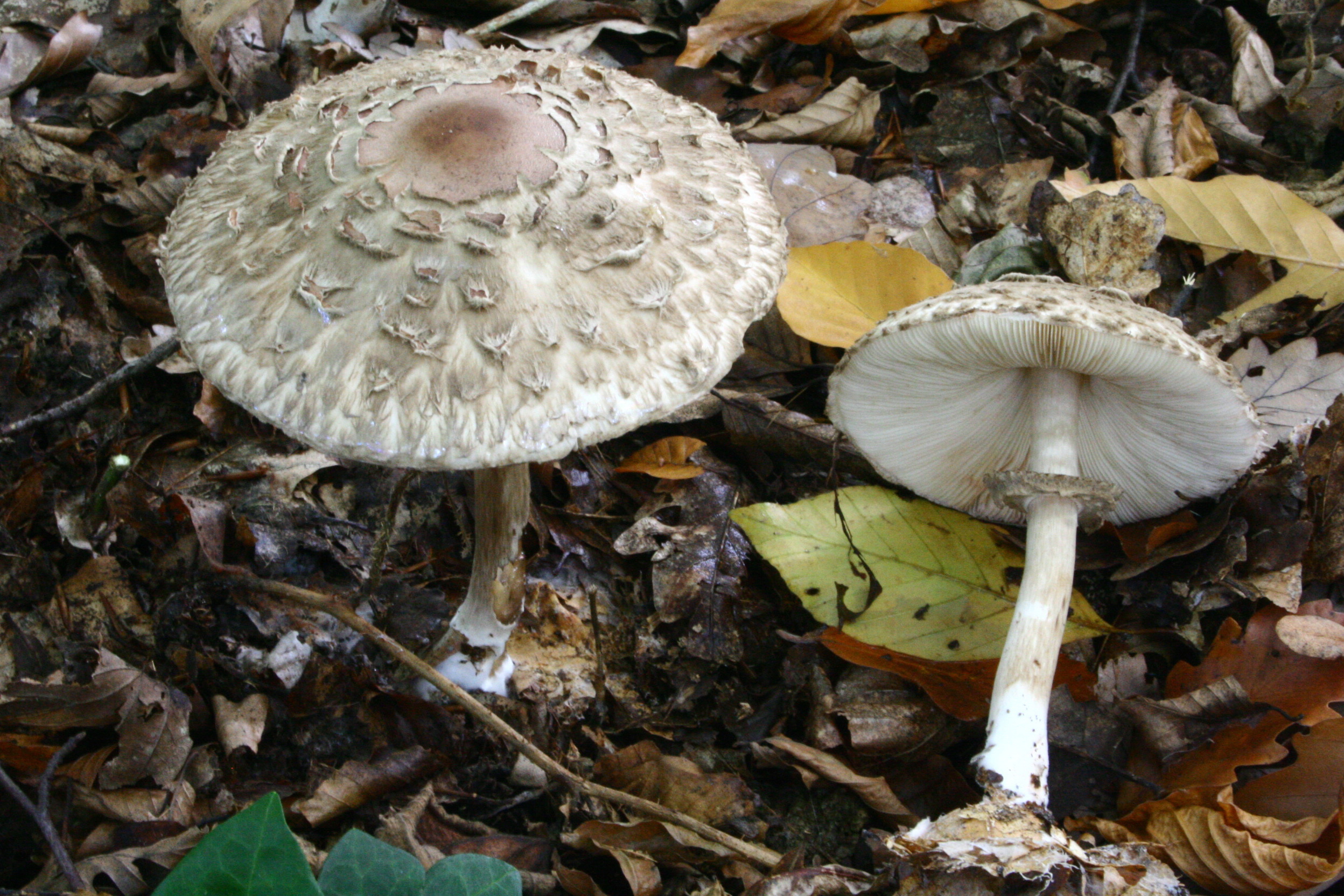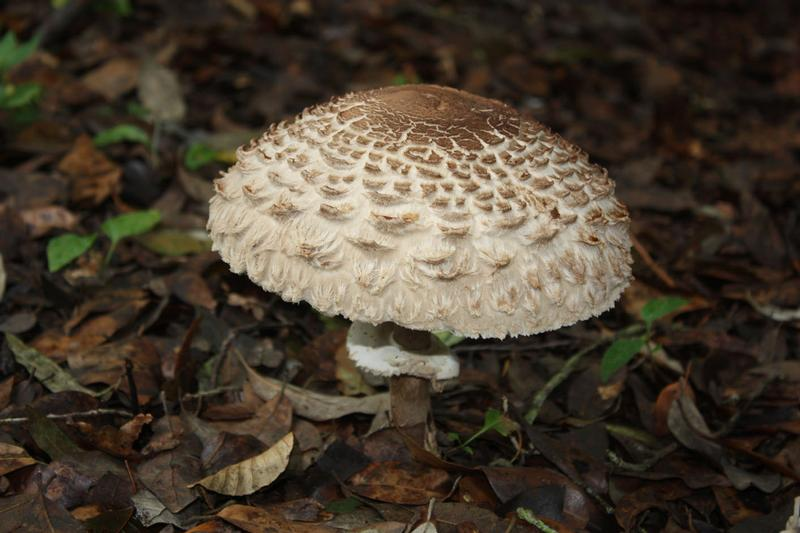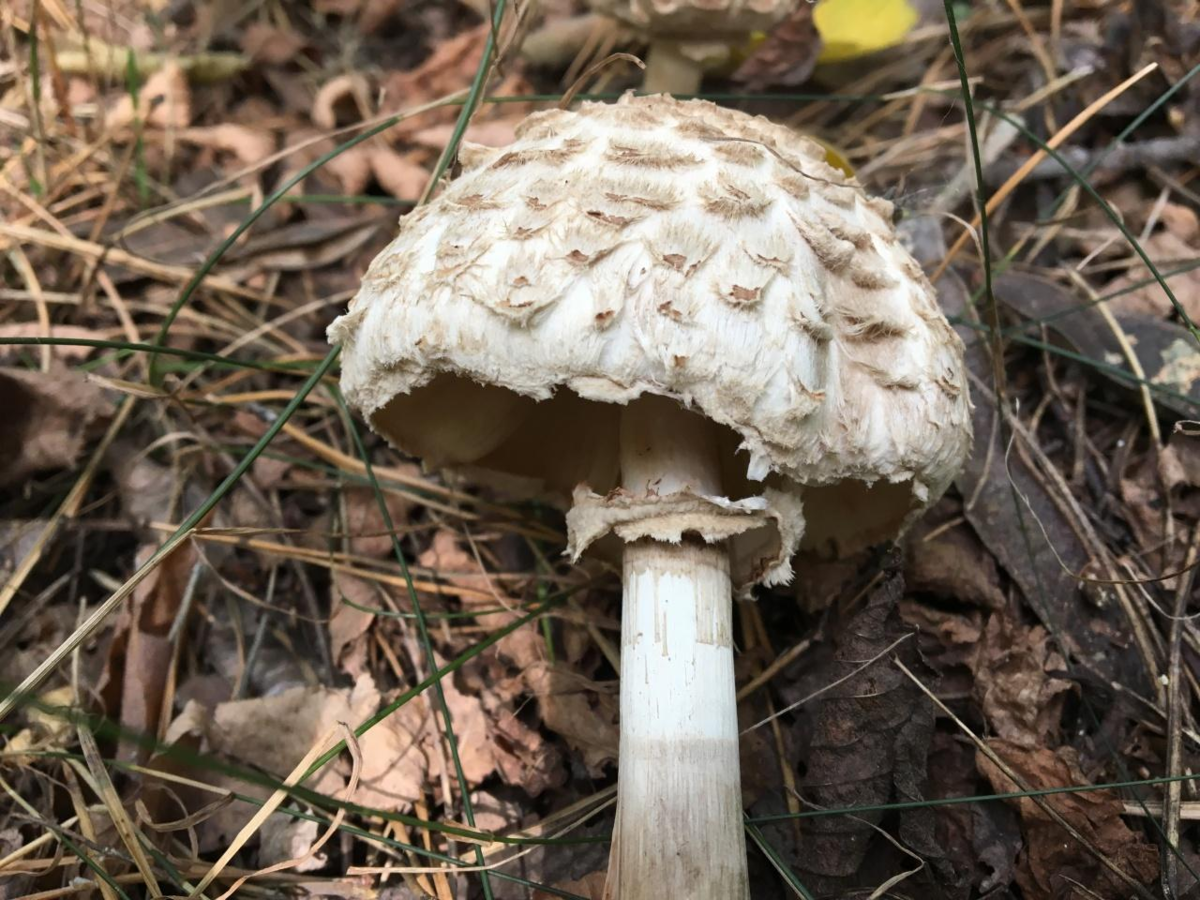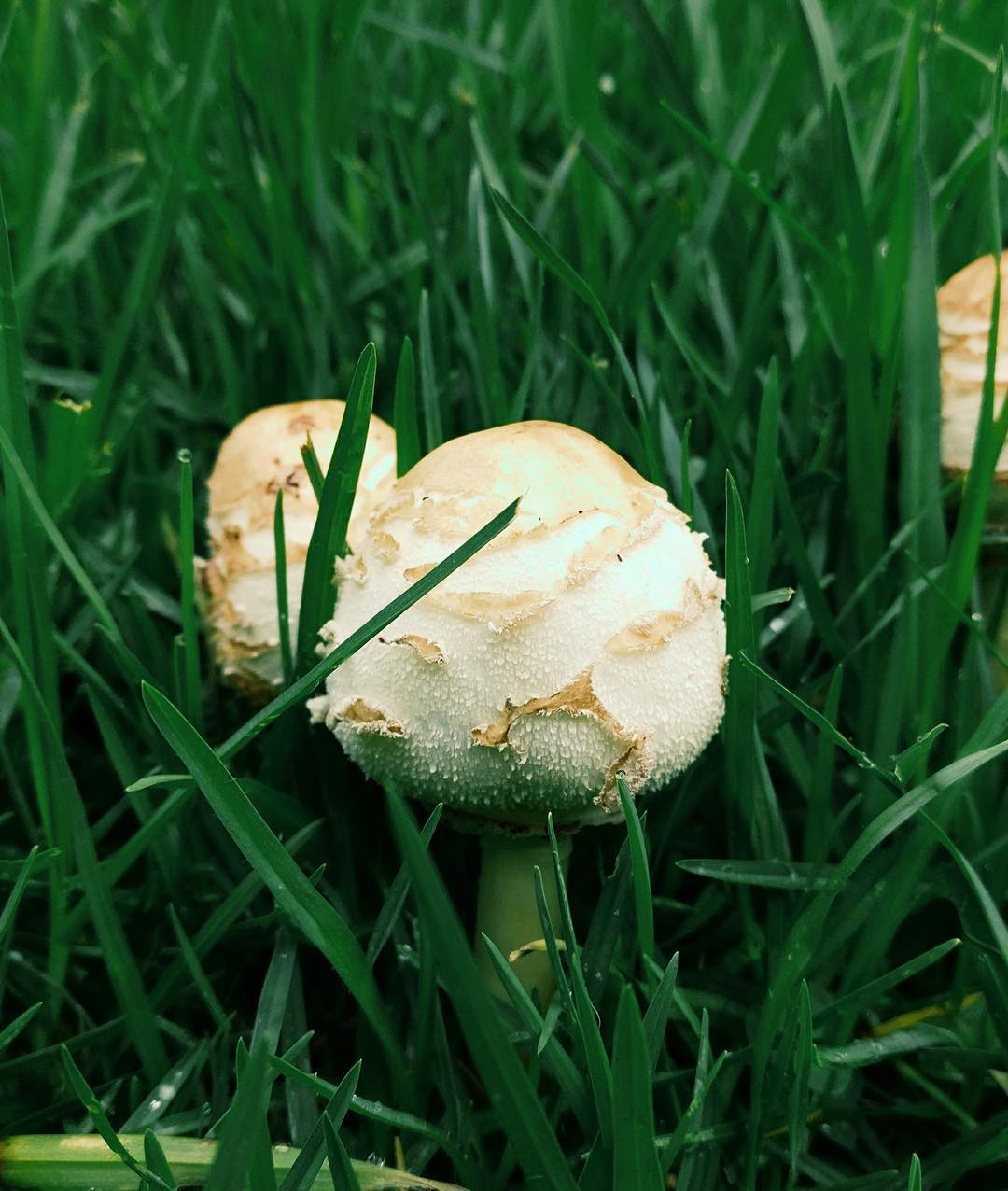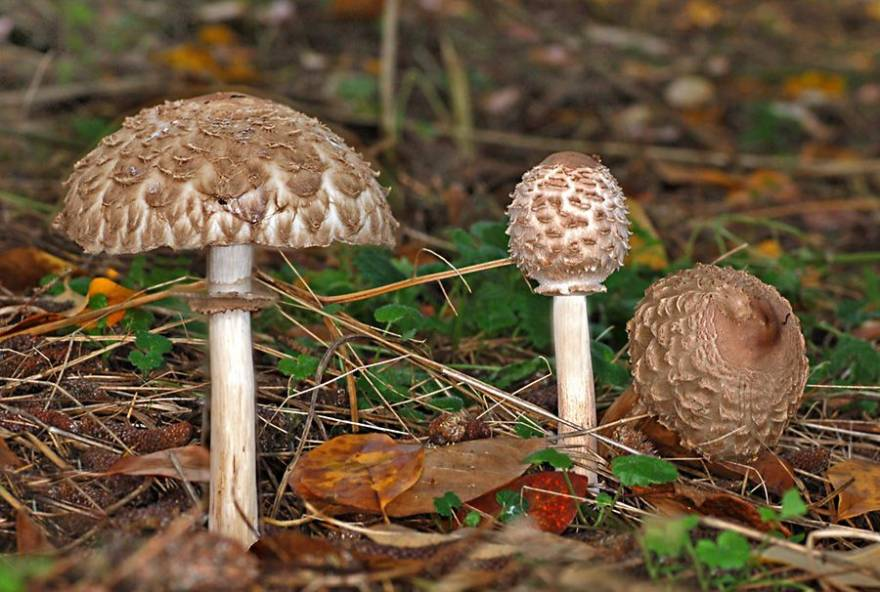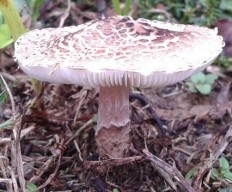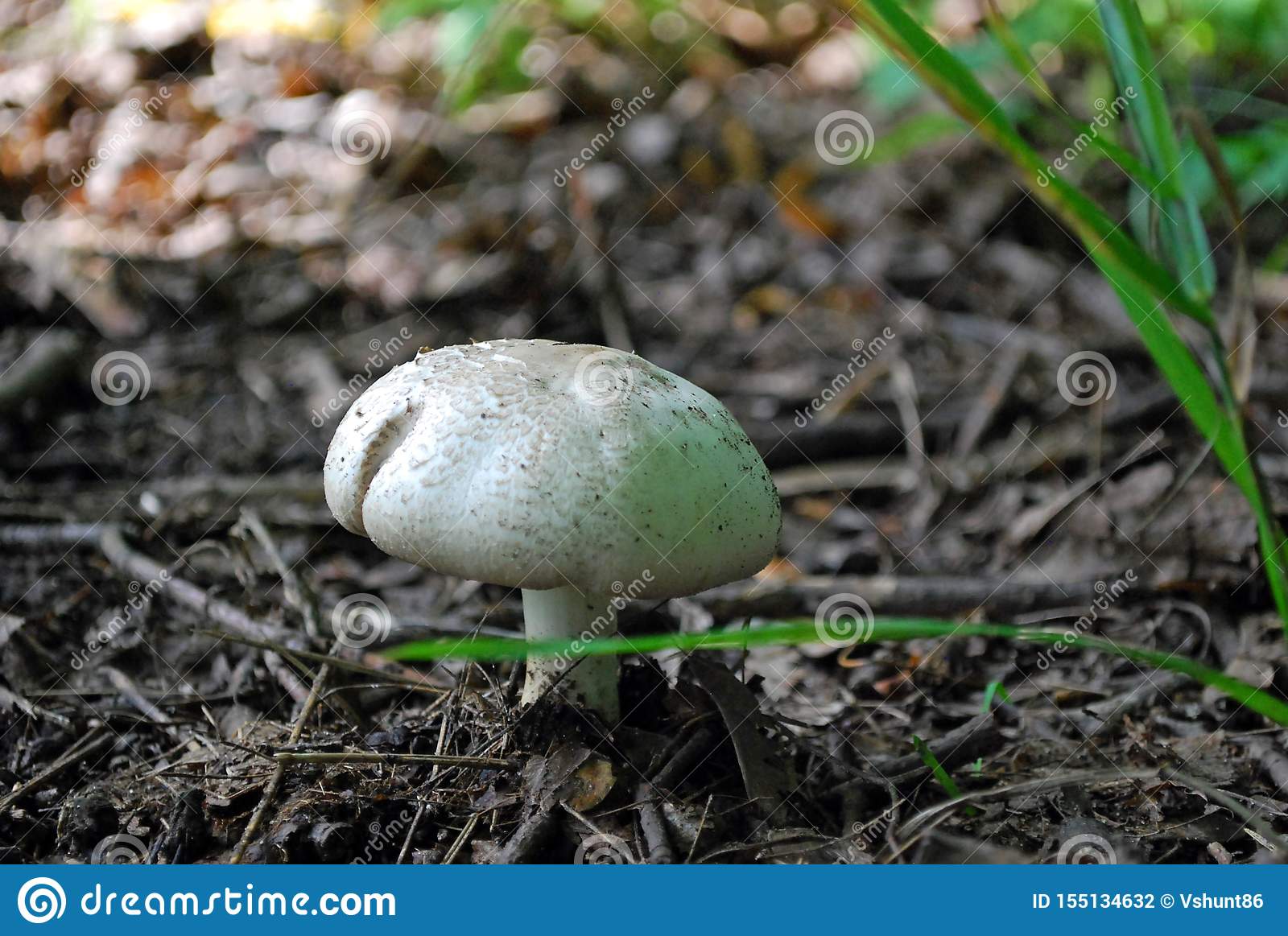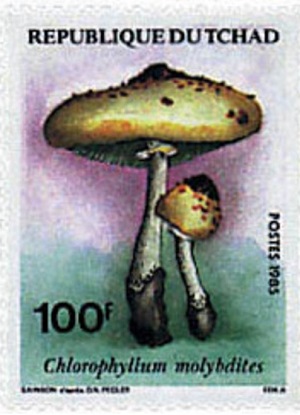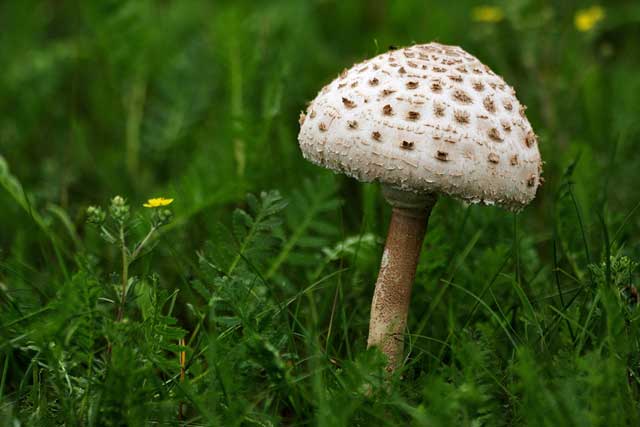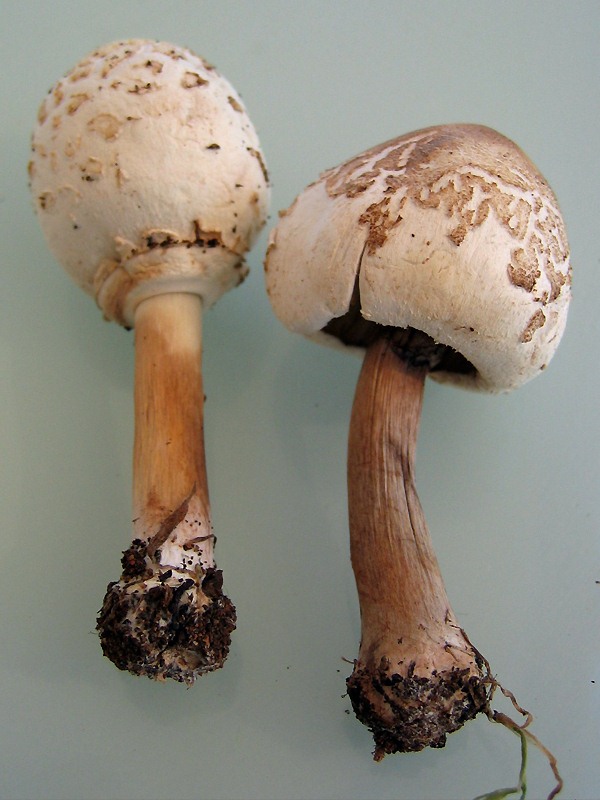Botanical description
The umbrella mushroom really looks like a big umbrella. In the forests, huge representatives of this species are often found, resembling giant umbrellas, lined up in a characteristic "witch circle".
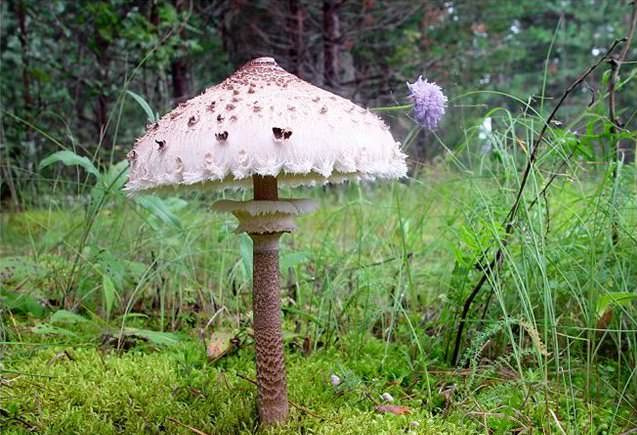
These edible and tasty mushrooms reach a height of 0.35-0.45 m, and the diameter of the cap reaches 0.25-0.35 m.In young specimens, the plates are closely pressed to the stem, with age they turn into a horizontal arrangement. There are many types of umbrellas, the main ones are presented in the table.
| Species name | Latin | Description of the hat | Leg characteristic | Features of the pulp |
| Mushroom umbrella variegated | Macrolepiota procera | In young specimens, it is spherical in shape, and with age it acquires a wide conical or umbrella-shaped shape. Surface with a dark, rounded tubercle in the center. Brownish-gray skin with angular scales | Cylindrical, hollow, with a rigid fibrous structure and a spherical thickening at the base | Whitish in color, quite dense, with a characteristic nutty taste and a weak mushroom odor |
| Mushroom umbrella graceful | Macrolepiota gracilenta | Fine fleshy, ovoid or bell-shaped, becomes almost flat with age, with a brownish tubercle in the center. Whitish skin with cracking and ocher scales | Cylindrical, with clavate extension and slight curvature | Snow-white, with a pleasant mushroom aroma and taste |
| Mushroom umbrella white | Macrolepiota excoriata | Flat-lying, with a large brown tubercle in the central part, whitish or cream colored, without shine | Cylindrical, hollow, with a slight tuberous thickening at the base | Fibrous, white, pleasant taste and aroma |
| Conrad's Umbrella Mushroom | Macrolepiota konradii | Relatively thick, convex-prostrate, with a papillary tubercle in the central part | Cylindrical, hollow, with a slight clavate thickening at the base | White and dense, with a pleasant mushroom aroma and taste |
| Mushroom-umbrella mastoid | Macrolepiota mastoidea | Fine fleshy, umbrella-shaped, with a large and well-defined pointed tubercle in the central part | Cylindrical, hollow, with a slight tuberous thickening at the base | Dense and soft, pure white in color, with a pleasant nutty flavor and mushroom smell |
| Mushroom umbrella blushing | Chlorophyllum rhacodes | Beige, umbrella-shaped, with cracking edges | Tapering at the top, hollow, with a smooth surface and a thickened base | Hard, fibrous, white, reddening at the cut |
| Mushroom umbrella girlish | Leucoagaricus nympharum | Fine fleshy, umbellate, with a low tubercle and thin fringed edges | Cylindrical, narrowed at the top, with a tuberous thickening at the base | It turns pink on the cut, has a rare smell, there is no pronounced taste |
Similar species
The blushing umbrella has similar species, both edible and poisonous. Mushroom pickers need to be very careful when collecting it.
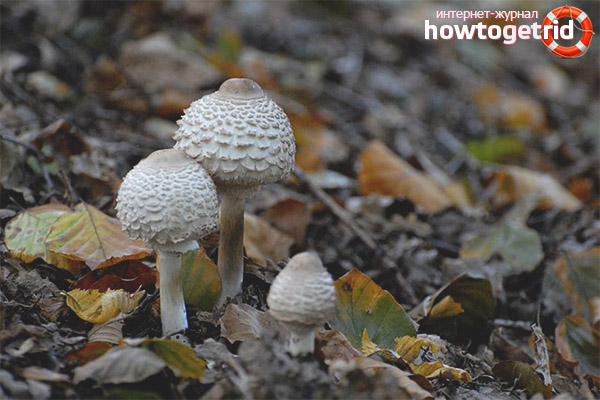
Edible mushrooms:
- Girl's umbrella (Leucoagaricus puellaris). Autumn resembles the aforementioned chicken coop, but its hat is lighter in color and the color of the mushroom changes very slightly on the cut.
- Umbrella variegated (Macrolepiota procera). The size of this mushroom is larger, that is, the cap exceeds 20 cm in diameter. The slice does not change in color.
- Thin umbrella (Macrolepiota gracilenta). This representative of the species is smaller than the blushing umbrella and also leaves its color when cut.
- Chlorophyllum dark brown (Chlorophyllum brunneum). It has a more brownish color. On the cap, the scales are larger in size than that of a blushing umbrella. On the leg, characteristic and quite noticeable thickening.
- Chlorophyllum lead-slag or Morgan's umbrella (Chlorophyllum molybdites). The mushroom is very poisonous and at the same time looks like a blushing umbrella.The cap ranges in size from 10 to 30 cm, white with brownish-pink scales. At a young age, it looks like a ball, and then opens to a flat state. The leg is also smooth, with a ring at the top. The pulp turns red on the cut, but does not have a pronounced odor. The fungus is widespread both in Eurasia and in African countries, Australia and America. The plates are white, but if you press on them they turn yellow and sometimes turn brown. Older mushrooms have greenish plates, the color of olives.
[edit] Classification
View Chlorophyllum lead-slag (Chlorophyllum molybdites) belongs to the genus Chlorophyllum (Chlorophyllum) to the Champignon family (Agaricaceae) order Agaric (Agaricales).
| 14 more classes in 3 subsections | 28 more families | about 20 more species | ||||||||
| Department Basidiomycetes | order Agaric | genus Macrolepiota | ||||||||
| kingdom Mushrooms | Class Agaricomycetes | family Champignon | view Chlorophyllum lead-slag | |||||||
| 6 more departments | 16 more orders | about 85 more deliveries | ||||||||
Varieties
According to the Index Fungorum website:
- Chlorophyllum molybdites var. congolense (Beeli) Heinem. 1967
- Chlorophyllum molybdites var. luteolosperma Singer 1946
- Chlorophyllum molybdites var. marginatus (A.H. Sm.) D.A. Reid & Eicker 1991
- Chlorophyllum molybdites var. molybdites (G. Mey.) Massee 1898
Synonyms
According to the website "MycoBank":
- Agaricus molybdites G. Mey.
- Lepiota molybdites (G. Mey.) Sacc.
- Mastocephalus molybdites (G. Mey.) Kuntze
- Leucocoprinus molybdites (G. Mey.) Pat.
- Macrolepiota molybdites (G. Mey.) G. Moreno
- Lepiota morganii Peck
- Lepiota ochrospora Cooke & Massee
- Chlorophyllum esculentum Massee
- Annularia camporum Speg.
- Agaricus guadelupensis Pat.
- Agaricus congolensis Beeli
Blushing Umbrella (Chlorophyllum rhacodes)
Synonyms:
Hat:
In a blushing umbrella, the diameter of the cap is from 10-15 cm (up to 30), first ovoid or spherical, then hemispherical, umbrella-shaped. The color of the cap is brown, with various shades. Adult specimens are densely covered with fibrous, tile-like brown scales, which are completely absent in young specimens. In the center, the cap is darker, without scales. The pulp is white, thick, becomes wadded with age, turns red on the cut. The smell and taste are weak, pleasant.
Plates:
The plates at the blushing umbrella are attached to the collarium (a cartilaginous ring at the junction of the cap and the leg), frequent, at first creamy white, then with a reddish tint.
Spore powder:
White.
Leg:
Long, up to 20 cm, 1-2 cm in diameter, in youth, strongly thickened at the bottom, then cylindrical with a tuberous base, hollow, fibrous, smooth, gray-brown. Often it is deeply immersed in fallen needles. The ring is not wide, collected, mobile, brownish.
Spreading:
The blushing umbrella grows from July to the end of October in spruce and mixed forests, often adjacent to anthills. During the period of abundant fruiting (usually the end of August) it can grow in very large groups. It can also bear fruit abundantly in October, during the "late mushrooms" period.
Similar species:
Often confused with a variegated umbrella (Macrolepiota procera), from which it differs in the place of growth (although not always), in smaller size, a much shagier cap, a smooth leg (in a variegated umbrella it is covered with transverse cracks and small scales), a darker ring, and the main thing is the pulp, rapidly reddening at the break, especially in the leg.
Edibility:
Among understanding people, the blushing umbrella is considered an excellent edible mushroom. The legs are said to be inedible due to their rigidity. I would argue with both the first and second statements ...
Remarks
Needless to say, an umbrella is a beautiful mushroom. Of course, this species, unlike Macrolepiota procera, is devoid of any grotesqueness, and rarely grows to the size of a good stool, but this, in my opinion, is already superfluous. A blushing umbrella is a bright mushroom with an established character, meeting with it is always a holiday. But it may not be worth depriving the old dark spruce forest of such decoration: the gastronomic glory of umbrellas, in my opinion, is greatly exaggerated. Cotton knitting pulp will delight only the deliberate lover. In a hungry year, however, you can chew on the elastic fibrous legs, having previously marinated them with spices. It turns out a little worse than autumn honey agarics.
Useful properties of the umbrella mushroom
Due to its excellent taste, the umbrella mushroom is a favorite subject of quiet hunting. Gathering umbrella mushrooms is better when young. In addition, they must be thoroughly heat treated. Very young umbrellas are successfully pickled, mature mushrooms are dried, salted and boiled, after which they are used to prepare broths, sauces, main courses, salads and fillings for pies and pancakes.
Umbrella mushrooms contain many substances useful for the human body:
- vitamins of group B, as well as C, E, K;
- potassium (up to 16%), sodium, magnesium, calcium, iron, phosphorus;
- tyrosine;
- arginine;
- beta glucans;
- melanin.
According to traditional healers, extracts and tinctures from umbrella mushrooms, as well as the direct consumption of these mushrooms, helps to fight a number of serious ailments, among them:
- vascular and heart diseases;
- rheumatism;
- disorders of the nervous system;
- oncological diseases.
Due to their low calorie content, umbrellas are included in various diets, including obesity and diabetes.

Similar poisonous species:
Chlorophyllum molybdites is found in North America, is smaller, its flesh turns red-brown when pressed, the spore powder is olive-green.
Chlorophyllum brunneum is smaller, with reddened flesh.
Compared to other members of the mushroom family, the variegated umbrella has the highest taste. So, in France, it is considered a delicacy and is used to prepare delicious dishes.
As a rule, young frying caps are used (pre-boiling is excluded). It tastes like chicken with a nutty flavor. Can be cooked like pancakes, dipped whole in beaten eggs, rolled in flour and fried.
Delicious as a filling for pies along with fried onions. Suitable for soups, pickling, pickling and drying. Sometimes raw is used for salads, sandwiches. In some countries, the tough legs are dried and ground into powder, which serves as a seasoning with a pronounced mushroom taste and smell.
In the Baltics, whole umbrella hats, breaded in breadcrumbs, are served as a delicacy dish in restaurants, and the umbrellas themselves are valued there higher than white, boletus and aspen mushrooms.
Description of lead-slag chlorophyllum.
At first, his cap is spherical, later becomes bell-shaped, and by old age it reaches almost flat. Its diameter is 6-32 centimeters. There may be scales or blanket residues on the surface of the cap. The color of the cap is most often white, and rarely grayish.

The pulp of lead-slag chlorophyllum is white, and at the site of damage it becomes pinkish or reddish. The pulp does not have a pronounced smell.
The leg is widened downwards, very smooth. Its length is 8-28 centimeters. Young specimens have a white ring at the top of the stem. The color of the leg is white, but at the site of damage it turns brown.

Places of growth of lead-slag chlorophyllum.
This type of mushroom bears fruit from May to September. Chlorophyllum lead and slag grows in North America, Eurasia and Australia. You can find these mushrooms in open spaces, for example, in forest glades and meadows.

Umbrella mushrooms and their poisonous counterparts: how to distinguish? Photo Tips
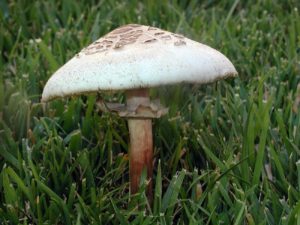
Umbrella mushrooms in our latitudes began to be massively collected only recently. Previously, this delicacy was known only to a narrow circle of mushroom pickers. Everyone else considered the umbrellas to be huge fly agarics or even a pale toadstool. And now, thanks to the Internet, mushroom pickers rushed to collect umbrellas and make delicious chops from them.
But how do you learn to distinguish and collect umbrellas and not confuse them with poisonous counterparts? Let's find out!
Which family of mushrooms does the umbrella mushroom belong to?
The umbrella mushroom (the one that is the largest and which is difficult to confuse with something else) is called the variegated umbrella (Latin Macrolepiota procera) and belongs to the mushroom family and can be eaten raw, without heat treatment (like the classic champignon).
Umbrella mushrooms are variegated (Latin Macrolepiota procera). It is them that need to be collected!
However, several types of fungi are popularly called umbrellas - some lepiots (scaly umbrella) and chlorophyllums (reddening umbrella, lead-slag chlorophyllum, brown umbrella mushroom). All of these species also belong to the mushroom family, but some of them are poisonous!
What umbrellas do I recommend to collect
Personally, I do not take any other umbrellas except the variegated umbrella (macrolepiota procera).
At the same time, you can only eat fresh, resilient mushrooms with light, not dried plates.
Leave rotten, lethargic, sun-dried, too old or too young specimens in the forest! By the way, you can determine the freshness of an umbrella by its smell - a fresh one will have mushroom, champignon, and dried or starting to deteriorate acquires a slightly fishy smell, like a taranka. Such umbrellas are not worth taking.
Do not take umbrellas with dark plates under the hat. At best, it will be a mushroom that has already begun to deteriorate, at worst it will be a sign of the poisonous twin of the umbrella, which you will read about below.
Place the umbrellas in a separate basket or on top of other mushrooms, as they will easily crumble and wrinkle if you put something else on top of them.
Do not take young, unopened specimens and suspiciously small in size, opened umbrellas - they are easy to confuse with poisonous mushrooms, which are twin of a variegated umbrella.
The umbrella is variegated in different stages of growth.
Can chlorophyllum rhacodes be harvested and eaten?
Mushroom pickers collect, but I do not take them, as they can easily be confused with lepiots or a brown umbrella. And their unpleasant reddish tint at the site of the cut or damage does not inspire confidence and desire to eat them.
For the same reason, I do not take maremukhas (edible amanitas are gray-pink). And according to the reviews of those who ate the blushing umbrellas, they may have allergic reactions and symptoms of mild poisoning.
Therefore, I do not recommend for allergy sufferers and people with a weak stomach to collect and eat umbrellas, the pulp of which turns red when damaged (cut or pressed).
Umbrella blushing
The appearance of a variegated umbrella
Fruit bodies of variegated umbrellas have a wide, scaly brownish cap with a convex top. It is “put on” on a high scaly brownish leg with a movable ring.
The cap of the mushroom is ovoid (egg-shaped) in young mushrooms, becoming bell-shaped, and then almost flat with age. The width across the cap is 10-25 cm, scales are attached to it in regular rows. In the middle there is a "bump", which is brown at first, cracks with age, shows white flesh. A ripe hat smells like maple syrup.
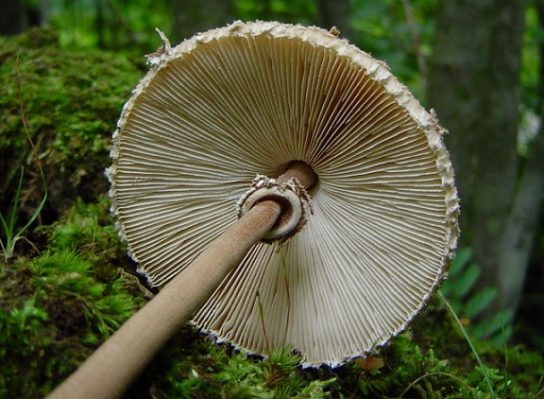
Motley Umbrella Hat
The gills (lamellas) are wide, with rough edges, white, closely spaced.
The leg is 7-30 cm or more in height. 7 / 20-12 / 20 cm thick. It grows to bulbous at the base, with brown scales that have a pattern somewhat resembling a herringbone. The partial curtain becomes a ring that moves up and down the leg.
Description of the variegated umbrella mushroom:
The variegated umbrella mushroom is an edible lamellar mushroom, known to some mushroom pickers as the large umbrella mushroom. It grows singly and in groups from late July to mid-October, consistently producing bountiful harvests, which peak in August-September. It is necessary to look for it in open areas of coniferous or mixed forest, clearings, as well as in rare thickets of bushes, gardens and along roadsides.
In young mushrooms, the cap is ovoid, with curved edges, from which a dense veil originates, hiding the spore-bearing layer. Gradually, the shape of the cap changes, it flattens and becomes prostrate with a barely noticeable tubercle in the middle. On average, the diameter of the cap of a mature mushroom is about 25-30 cm, but in some specimens it can reach 40 cm.
The surface of the cap is dry, dull, densely covered with lagging brown scales of various sizes, and along the edge there are also small cracks. The skin is painted in various shades of brown, the edge of the cap is decorated with an intricate ornament of white flakes.
The plates are rare, loose, fragile; they are separated from the stem by a thin movable white ring. Over time, their white color acquires a pronounced pinkish tint. In the process of growth, the club-shaped stem becomes even, leaving a slight thickening in the form of a tuber at the base. Its surface is brown colored and covered with light ring-shaped cracks. Inside, the leg is hollow, has a fibrous structure. The pulp is soft, cotton-like, with a pleasant nutty smell, becomes dense with age, and even stiff in the leg.
Characteristic features of a blushing umbrella
The blushing umbrella is very similar to other types of umbrellas. The most striking feature characteristic of this species is the reaction to air during mechanical damage.
Description of appearance and photo
A detailed description of the appearance of the mushroom and a photo will make it possible to distinguish it in the forest:
- The fruiting body consists of a cap and a stem, which can be easily separated.
- Hat in light shades: gray-beige, beige.
- The leg is beige. There are many rings on it, so it gives the impression of being striped.
- The mushroom has a rather impressive size: the diameter of the cap reaches 20 cm, and the length of the leg is up to 25 cm.
- The hat has dark patches that are typical for all umbrellas.
Young fruits resemble chupa-chups caramel: a rounded hat is attached to a long thin stem. Adult mushrooms are like umbrellas, because as they mature, the cap straightens the edges, taking on an umbrella-like shape. You can examine the details of the appearance in the photo of the mushroom.
Structure and species differences
Initially, the cap is egg-shaped or spherical, the edges are wrapped inward. Then it becomes wide-conical. In old mushrooms, the cap takes on an umbrella-shaped shape, straightening the cracked edges. The surface is radial fibrous.
The main tone of the cap is beige, but the tubercle located in the center is always a tone or two darker. On the surface of the cap there are easily peeling scales, in the form of dark brown rags.
The leg is cylindrical, hollow inside, has a tough fibrous texture. Can be straight or curved. It is spherically thickened at the base. The leg has a ring that easily moves over its entire surface. Volvo is missing. Also on the leg there are remnants of a filmy bedspread, white on top and brownish at the bottom. It comes off the surface easily. The leg is effortlessly detached from the cap.
The plates are thick. They taper towards the pedicle, form a cartilaginous collarium. In young umbrellas, the plates are white, but as they age, they acquire a creamy or beige hue. The plates are easily detached. When pressed, they turn red-orange. The spores of the fungus are white or cream colored.
 Description of the mushroom
Description of the mushroom
The pulp is fleshy. In young animals, it is loose, but over time it becomes more dense. The pulp is white, when cut it acquires a reddish tint - hence the name of the species. The pulp has a pronounced mushroom smell and a pleasant nutty taste.
Place of distribution
You can search for umbrellas in different types of forests. They can also be found in steppes, parks, fields, meadows and household plots. More often the mushroom grows in groups resembling circles or rows, very rarely - singly.
Umbrellas are common throughout the globe, with the exception of the lands of Antarctica. They grow especially abundantly in Eurasia, namely in Turkey, Siberia, Transcaucasia, China, Japan, as well as in Australia and the American continent (Canada, USA, Chile) and even North Africa.
Eating
The blushing umbrella belongs to the category of edible mushrooms. It has a pleasant taste and is appreciated by culinary experts all over the world. However, eating the mushroom raw is not recommended.
Important! Before eating, it must undergo at least a minimum heat treatment.
Rules and places of collection
The rules for collecting umbrellas do not differ from the general principles of mushroom picking:
- Do not take dubious items into the basket.
- Do not tear or break the mushroom units, but carefully cut with a knife so as not to destroy the mycelium.
- Go on a mushroom hunt in the early morning.
- On the spot, reject rotten or wormy units so as not to take up space in the basket.
- Go for mushrooms with wicker baskets or baskets and do not use plastic bags.
Umbrellas prefer to grow in open, well-lit areas. There are especially many of them on humus-rich lands. Mushrooms are found singly or in small groups. Sometimes they form rows or rings, known among mushroom pickers as witch circles.
Umbrella blushing
Umbrella blushing - Chlorophyllum rhacodes
Where does this mushroom grow
This champignon prefers oily humus soils, glades, parks, meadows, steppe and other open places, and a temperate climate.
It is collected in European countries, Chile, USA, Morocco, Turkey, Algeria. It is found in the Transcaucasian, Siberian (Altai and Krasnoyarsk regions), Canadian and Australian lands.
Usually it grows in groups, very rarely - one by one.
Fruiting in June - November.
What does a blushing umbrella look like?
Stipe
The length of the cylindrical, tapering to the top and empty inside the leg reaches 10-25 cm, the thickness is no more than two centimeters. Despite the smoothness, there may be small fibers on the surface.
The tone of the young leg is whitish, the more mature is brown.
It is equipped with a movable filmy ring, the top of which is painted white, and the bottom is brownish. The ring contains scales with bifurcated edges. There is no vulva.
Mushroom hat
The chicken coop builds up a fleshy voluminous cap from 10 to 20 cm in diameter. In a young mushroom, it is spherical; as it ripens, it takes on the shape of a bell and turns into a flat umbrella, in the middle of which a smooth wide mound rises.
The hat is available in beige, brownish and taupe, with the darkest area in the center. It is covered with large fibrous scales arranged in a circle.
The bottom of the caps is densely speckled with wide free plates (no more than 1.5 cm in width) of a white or cream shade. Near the leg, they form something like the thinnest collarium, and if you press on them, they acquire a red-orange color.
Cream or white spores ripen on hats.
Red umbrella (Chlorophyllum rhacodes), description of the fungus
Similar species
The blushing umbrella is sometimes confused with other mushrooms, both edible and poisonous.
Edible similar mushrooms
- The umbrella is girlish. In Latin it is called Leucoagaricus puellaris. This mushroom is unlike its counterpart in that its hat is much lighter and the flesh almost does not change color when cut.
- The umbrella is colorful. The Latin name is Macrolepiota procera. Differs in larger size and pulp that does not change color when cut.
- The umbrella is thin. Macrolepiota gracilenta is smaller than its blushing counterpart and does not turn red when cut.
Poisonous similar mushrooms
- Morgan's Umbrella. Chlorophyllum molybdites is native to North America and has an olive-green spore print.
- Chlorophyllum is dark brown. In contrast to the Umbrella of blushing, Chlorophyllum brunneum is colored brown. Its cap is covered with larger scales, and the leg has a powerful thickening at the bottom.
The red umbrella has delicate caps with a pleasantly smelling white pulp, which after cutting takes on a reddish-brown hue. It is hats that are used for food, since the legs are too coarse in structure. Before cooking or drying, raw materials are cleaned of scales.
Cooking methods
Macrolepiota is very easy to prepare. These mushrooms are suitable for making soups, delicious and nutritious second courses, cold snacks.
Even novice housewives can cook aromatic soup from umbrellas:
- rinse and soak the mushrooms for a couple of hours in cold and salted water;
- rinse the mushrooms again and cut into small pieces;
- chop onions and potatoes;
- grate peeled carrots;
- sauté onion with carrots in vegetable oil until tender;
- Pour mushrooms with water, bring to a boil and cook for 20-25 minutes;
- add potatoes to the soup, and after 15 minutes add sautéing and spices and cook until tender.
Mushroom soup should be served with fresh herbs and fresh sour cream.
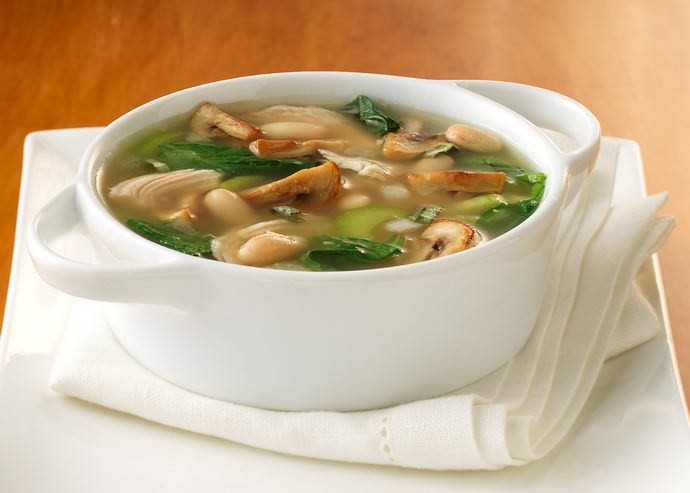
Baked umbrellas have a unique mushroom aroma and delicate taste, which are prepared according to the following recipe:
- gently peel and rinse the mushrooms, remove the legs completely;
- beat eggs with salt and chopped garlic in a blender;
- dip the mushroom caps into the egg mass and roll in breadcrumbs.
The resulting mushroom blanks can be baked in the oven or fried in a hot pan until golden brown. You can use this dish not only hot, but also cold.
How to distinguish an umbrella from poisonous mushroom twins
Edible umbrella mushrooms have counterparts not only in the Champignon family, but also among others. These are certain types of fly agaric and chlorophyllum, the names and photos of which can be found in specialized literature. The main task of the mushroom picker is to distinguish umbrellas and mushrooms from deadly poisonous relatives.
Umbrella and fly agaric panther
If we compare the photo, the description of the representatives of the genus Macrolepiota and the panther fly agaric, we will be able to notice that not only the hat differs, but also the appearance of the pulp. So, in the panther fly agaric, the poisonous cap first has the shape of a hemisphere, then it becomes bell-shaped or flat, brown-brown. Its surface is covered with whitish flaky scales.
The stem of the fungus is thin, white or gray-dirty, in the lower part it has a tuberous base. The ring may be missing. The pulp of the fly agaric, in contrast to the blushing umbrella, is only white, which does not change color when broken. It has a sweetish unpleasant odor and taste.
Amanita muscaria can be found in the northern regions.
Umbrella and stinky fly agaric
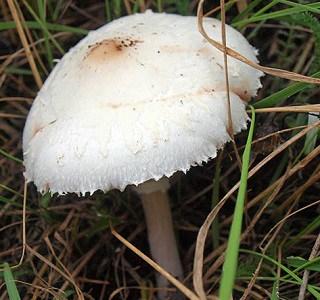
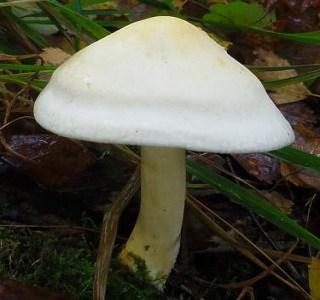
White grebe, or stinking fly agaric, is a species that is highly toxic and leads to death when consumed in food in almost 90% of cases. You can confuse it with false and edible umbrella mushrooms.
Young eukaryotes are egg-shaped, straighten out over time, reach 10 to 15 cm in height and, with age, acquire a cylindrical stem with a tuberous thickening at the base. The cap of the fly agaric has a hemispherical or conical shape, which becomes only slightly convex in old age. The surface is covered with flakes, in contrast to Macrolepiot, in which the scales are formed due to cracking of the skin on the cap. The color is pure white or grayish, the edge of the cap may be pinkish.
The pulp on the break is only white, very unpleasant smelling. Macrolepiots, on the other hand, have a faint but pleasant aroma.
Umbrella and chlorophyllum dark brown
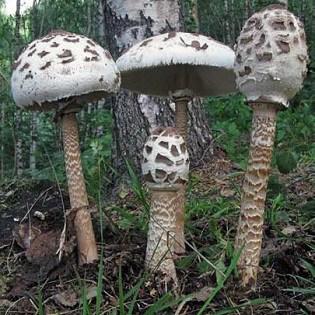
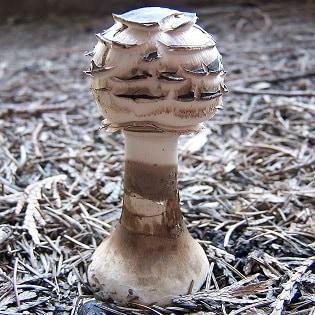
Chlorophyllum is the same variegated mushroom as the umbrella, which has a cap covered with scales and a ring. Its main difference lies in the small length of the leg, which is also quite thick and dense. In Russia, dark brown chlorophyllum is not found.
Umbrella and chlorophyllum lead and slag
The poisonous twin of the umbrella has a white surface covered with rare pink scales. Initially, the white leg of the fungus becomes olive or gray-green with age, which is not inherent in representatives of the Macrolepiota genus. When pressed, the plates turn brown or yellow. This species does not grow on the territory of Russia.

